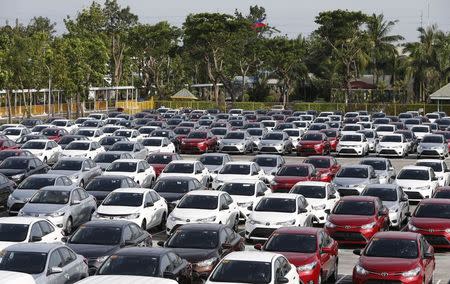Policy delay has Japanese carmakers reviewing Philippines expansion plans

By Rosemarie Francisco MANILA (Reuters) - Top Japanese automakers in the Philippines are threatening to shift production to cheaper Southeast Asian countries as the government drags its feet on a plan to rebuild its shrinking car manufacturing industry. The potential pullout of production lines by Toyota Motor Corp and Mitsubishi Motors, which have a combined 50,000 vehicle annual capacity in the country, would mean the Philippines could lose more than 1,000 jobs and millions of dollars worth of planned and existing investments. Time is running out, industry officials say, because there's less than two years left in the term of President Benigno Aquino, who has been backing the plan. "I believe that if this does not get approved this quarter and signed by the president by the end of the year and even in the first quarter next year, then let's forget about it because nothing will happen anymore," said Ferdinand Raquelsantos, head of the motor vehicle parts industry group MVPMAP. The original government plan includes tax incentives to help rebuild the country's tiny auto industry and turn it into a major manufacturing hub. But two years of government and industry debates, revisions and disagreements over how best to grow the auto sector have carmakers saying they may move to cheaper countries like Malaysia and Indonesia. The reforms have also been delayed because Manila wants the industry to ramp up production first to produce 40,000 units of a single car model annually before they can use the incentives. Industry insiders say only Toyota could meet that requirement with no incentives. The carmakers had hoped to capitalize on the government roadmap to boost local production after car sales hit record highs for several months this year on robust consumer spending, and vehicle ownership remains the lowest among Southeast Asia's five biggest economies at just around 35 per 1,000 people. "We have been telling the government, please issue the roadmap so there will be a clear policy direction and basis for Toyota's investments in the Philippines," Rommel Gutierrez, spokesman of Toyota Philippines, told Reuters. Gutierrez also serves as president of the auto industry group CAMPI. "The mother company in Japan has many options, Thailand, Malaysia, Indonesia...As early as now, it is already scouting (for locations)," Gutierrez said, adding it's debating whether to continue production of Vios compact and Innova in the Philippines in the absence of clear policy direction. The Philippine unit of Mitsubishi Motors, which has been planning to more than triple its existing capacity after purchasing a former Ford Motors plant earlier this year, hasn't decided on starting local production of new models. "Without the EO (executive order), I am not so sure if we will launch a new car or not," Hikosaburo Shibata, president and chief executive of Mitsubishi Philippines, told Reuters. RUNNING OUT OF TIME Government officials declined to comment on a target date for the roadmap, but automakers say based on discussions with the government the plan will likely be released this year. "We have to balance. It's always a cost-benefit trade-off," said Trade Secretary Gregory Domingo, adding the government is continuing consultations with industry and state agencies. Carmakers are hoping the plan will include adequate fiscal and non-fiscal incentives such as tax credits and common testing facilities for auto parts makers to ease manufacturing disadvantages. It costs around $1,800 to $2,000 more to produce a locally assembled car than it is to import a complete vehicle, according to industry estimates. The Philippines ceased being a car exporter after Ford closed local production in 2012 partly due to increasing imports of pre-owned cars, most of them smuggled, and tariff relaxation after trade deals. (Additional reporting by Karen Lema; Editing by Miyoung Kim and Matt Driskill)

